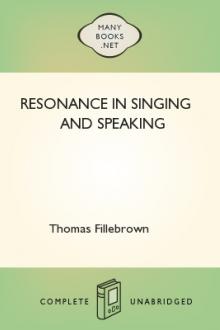Resonance in Singing and Speaking by Thomas Fillebrown (book suggestions .TXT) 📕

- Author: Thomas Fillebrown
- Performer: -
Book online «Resonance in Singing and Speaking by Thomas Fillebrown (book suggestions .TXT) 📕». Author Thomas Fillebrown
To acquire control of breathing, proper exercises must be intelligently and persistently followed. In mankind, nature seems to have been diverted from her normal course so that we seldom find an individual who breathes correctly without education in the matter. What we have said on breathing is based on the premise that respiration involves coördinate action of the body from collar-bone to the base of the abdomen; that is, expanding and contracting the chest and abdomen simultaneously. This is called "lateral-abdominal" breathing; as the chest is the thoracic cavity, "abdomino-thoracic" has been suggested as brief and more strictly scientific.
Work on any other lines fails to develop the full power and quality of the voice. Weak breathing is a prime cause of throaty tones. In such cases an effort is made to increase the tone by pinching the larynx. But this compresses the vocal cords, increases the resistance to the passage of the breath, and brings rigidities that prevent proper resonance. The true way is to increase the wind supply, as does the organist.
CORRECT BREATHING ILLUSTRATEDThe following figures show the outline of correct breathing. The inner abdominal line shows the limit of expiration; the outer line shows the limit of full inspiration.
Figure 9 shows the limit of full expiration and inspiration of the male, side view.
Figure 9
Figure 9.
Figure 10 shows the lateral expansion of the ribs in both expiration and inspiration, front view of the male.
Figure 10
Figure 10.
The expansion cannot be great at this part of the chest, as the side is so short a distance from the backbone to which the ribs are attached. The movement of the ribs in front is much greater, as Fig. 9 shows.
Figure 11 shows the front expansion and contraction in the breathing of the female, side view.
Figure 11
Figure 11.
Figure 12 shows the lateral expansion of the chest in the female, front view.
Figure 12
Figure 12.
These diagrams are made from photographs, and thus true to life. It will be noticed that there is no difference in the breathing outline between these subjects. The female subject, though a good singer, had had no training in breathing. She previously insisted that she used only the chest breathing, and did not use the abdominal muscles, but actual test revealed the condition to be that shown in Figure 11 and convinced her that she was mistaken.
It is not unlikely that many other singers who now think they are using only the high chest respiration would, if subjected to the same test, find themselves similarly mistaken.
The contraction incident to forced expiration is much more tense than the enlargement of forced inspiration. When singing or speaking, forced inspiration is not used. Experience shows that the change in size of the body during speaking or singing is usually small. Occasionally, long passages in music demand that the expulsive power of the breathing apparatus be used to its limit.
ECONOMY OF BREATHThe quantity of air taken in with a single inspiration is, in quiet breathing, according to Prof. Mills,[3] from twenty to thirty cubic inches, but this may be increased in the deepest inspiration to about one hundred cubic inches. In forcible expiration about one hundred cubic inches may be expelled, but even then the residual air that cannot be expelled is about one hundred cubic inches.
It is not, however, the quantity of breath inhaled that is significant, it is the amount controlled. Get, therefore, all the breath necessary, and keep it, but without undue effort and without rigidity.
To test the amount of breath used in prolonged vocalization, a person skilled in the art of breathing, after an ordinary inspiration, closed his lips, stopped his nostrils, and began to vocalize. He found that the mouth with distended cheeks held sufficient breath to continue a substantial tone for twenty-three seconds.
While these experiments show that very little amount or force of breath is needed to produce effective tones, the impression must exist in the mind of the performer that there is a free flow of breath through the larynx; otherwise the tone will seem restricted and will be weak. The forced holding back of the breath begets a restraint that has a bad effect on the singer's delivery. While the breath must be controlled, there is such a thing as an exaggerated "breath control" that makes free delivery of the voice impossible.
It is quite possible to overcrowd the lungs with air. Do not, therefore, make the mistake of always taking the largest possible breath. Reserve this for the climaxes, and inhale according to the requirements of the phrase and its dynamics. The constant taking of too much breath is a common mistake, but trying to sing too long on one breath is another.
THE INITIAL USE OF BREATH FORCEThe breath force when properly employed seems to be expended in starting the vibrations in the larynx; the vibrations are then transmitted to the air in the resonance cavities, and there the perfected tone sets the outer air in motion, through which the tone vibrations are conveyed to the ear of the listener.
RESERVE BREATH POWERThe correctly trained singer or speaker will never allow the breath power to be exhausted. Some breath should be taken in at every convenient interval between the words, according to the punctuation, but never between syllables of a word;, this is correct phrasing. In this way the lungs are kept nearly full, and breathing is at its best.
The chief cause of breath exhaustion is wasted breath. This waste comes from exhaling more breath (more motive power) than the tone requires, and breath that does not become tone is wasted. This fault is largely induced by lack of proper resonance adjustment.
The singer should always feel able to sing another note or to speak another word. To sing or speak thirty or forty counts with one breath is useful practice but poor performance. Occasionally, long runs in singing may compel an exception. Half-empty lungs lower the pitch of the tone, lessen the resonance, and weaken the voice, rendering the last note of the song and the last word of the sentence inaudible. The breathing must not be forced, but enough air must be furnished to produce the proper full vibrations.
BREATH MASTERYWhat then does perfect control of the breath mean?
1. Ability to fill the lungs to their capacity either quickly or slowly.
2. Ability to breathe out as quickly or slowly as the occasion demands.
3. Ability to suspend inspiration, with the throat open, whether the lungs are full or not, and to resume the process at will without having lost any of the already inspired air.
4. Ability to exhale under the same restrictions.
The above four points are common to speaking and singing, but singing involves further:
5. Ability to sing and sustain the voice on an ordinary breath.
6. Ability to quietly breathe as often as text and phrase permit.
7. Ability to breathe so that the fullest inspiration brings no fatigue.
8. Ability to so economize the breath that the reserve is never exhausted.
9. The ability to breathe so naturally, so unobtrusively, that neither breath nor lack of breath is ever suggested to the listener—this is the very perfection of the art.
CHAPTER IV Breathing ExercisesEnough has been said in the preceding chapter to make clear the necessity of breath control, and to show what constitutes this control for the singer—the professional breather.
If the singer's breathing is nothing but an amplification of normal, healthy breathing, why dwell upon it, why not let it develop of itself?
Unfortunately, many teachers have taken this attitude, overlooking the fact that, although life is dependent on normal, healthy breathing, such breathing is, in civilized communities, not the rule but the exception, simply because normal living is rare; the artificiality of modern life forbids it. The high pressure under which most people live induces mental tension together with the consequent nervous and muscular tension. We are, without being conscious of it, so habituated to unnatural tension that automatic breathing is shallow and irregular instead of being deep and rhythmic.
The task, therefore, is to reclaim a neglected birthright—natural breathing—to make it habitual and amplify it.
PRELIMINARY SUGGESTIONS1. Breathing exercises to be invigorating and purifying demand plenty of fresh air.
2. At first do not practise longer than ten minutes at a time, three times a day.
3. Gradually lengthen the time without overdoing. When tired stop.
4. The best time is before dressing in the morning, with the window open. The worst time is directly after a meal.
5. Maintain throughout an easy, flexible poise.
6. Breathe as deeply as possible without abdominal distention. The greatest expansion should be felt at the lower end of the breast-bone.
7. Breathe as broadly as possible, expanding the sides without tension.
8. Breathe as high as possible without shoulder movement or stiffness.
9. Use not the high breath alone, or the mid-breath, or the low breath, but use the complete breath.
10. Breathe rhythmically by counting mentally.
11. Breathe thoughtfully rather than mechanically.
12. Do not crowd the lungs or lay stress on the mere quantity of air you can inhale. The intake of breath is, for the singer, secondary to its control, economy, and application in song. Increase of lung capacity will duly appear.
13. When not singing, speaking or practising an exercise that demands it, keep your mouth shut.
ATTITUDEDress the neck and body loosely, so as to give the throat and trunk perfect freedom. Place the hands on the hips, so as to free the chest from the weight of the arms. Stand erect, evenly upon the balls of the feet; the body straight, but not strained. Raise the back of the head slightly without bending the neck. This action will straighten the spine, place the chest forward, and bring the abdomen backward into its proper relation.
The great majority of people are shallow breathers, chest breathers, who when told to take a "deep breath" do not know what is meant. It is therefore necessary for them first to learn what a deep breath is, and then how to take it.
Exercise I FOR THOSE WHO DO NOT KNOW WHAT A DEEP BREATH ISBefore rising in the morning, remove your pillow and while flat on your back place one hand lightly on the abdomen, the other on the lower ribs. Relax the whole body, giving up your whole weight to the bed. Inhale through the nostrils slowly, evenly, and deeply, while mentally counting one, two, three, four, etc. As you inhale, notice (a) the gradual expansion of the abdomen, (b) the side expansion of the lower ribs, (c) the rise and inflation of the chest, without raising the shoulders. Hold the breath while mentally counting four (four seconds), then suddenly let the breath go, and notice the collapse of the abdomen and lower chest. Remember the inspiration must be slow and deep, the expiration sudden and complete. Practise this preliminary exercise for not more than ten minutes each morning for a week. The second week hold the breath six seconds, instead of four, and gradually increase the time, without overdoing.
While, for a novice, the exercises may be taken at first in bed, this is but





Comments (0)